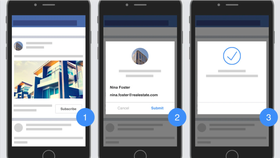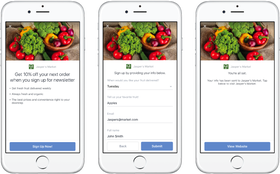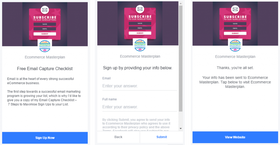Why AdRoll is Your Ideal Programmatic DSP
AdRoll helps you run full-funnel, multi-channel ad campaigns. Learn how our programmatic DSP enables better ad campaigns that convert customers.
Read More
Facebook carousel ads, check. Slideshow ads, check. Stories ads, video ads, dynamic retargeting ads — check, check, and check.
You may be a Facebook ad extraordinaire, but there’s one powerful Facebook ad type you may not be using yet: lead ads. Though they’re less commonly found in ecommerce marketers’ toolboxes, lead ads pack a massive punch when it comes to helping grow your Shopify business.
But what are Facebook lead ads, and how do they work? Even more importantly, how can you get started with them ASAP?
Facebook lead ads are an ad format that can be used to — you guessed it — drive leads.

How Lead Ads flow.
Resembling organic Facebook or Instagram posts, lead ads are placed in a user’s newsfeed and have the sponsored post label. They work by providing the user with a lead generation offer such as:
A discount code
Access to an exclusive piece of content
Registration for an event
Subscription to an email newsletter

An example of a lead form.
To unlock said offer, a user has to submit a lead form with their personal information, such as their name, email address, or phone number. Once they complete the lead form, you can either deliver the offer code immediately in the app or via email.
As any lead generation marketer will tell you, it’s typically challenging to get people to fill out a lead form — users can easily get distracted, start worrying about their data privacy, or wonder whether your offer is worth their effort.
In typical lead generation conversion journeys, users who interact with either an ad or a social media post must visit an external landing page, usually on your website, to fill out a lead form. While this is an effective way to find high-quality leads (since these users are going through the effort of leaving behind what they were doing to fill out your form), completion rates are usually low, especially among users who are only mildly interested in what you have to offer.
Facebook lead ads, on the other hand, offer a seamless user experience by minimizing the click-through path for completing the lead form — the key to boosting conversions. Not only is the lead generation form built natively into the platform (in other words, no need to switch between the platform and your website), but Facebook will also auto-fill the form with their information. By making it as easy as possible, lead ads set users up for success, aka fully completing your form.
Here are a few more perks of using Facebook lead ads:
Lead ads (and their corresponding lead forms) are designed to be mobile responsive. Rather than worrying about the design of a landing page, you can rest assured that your users won’t have trouble filling out your form.
You can save the time, resources, and efforts you otherwise would have spent creating a landing page or conversion path from scratch. All the data you collect via lead ads are saved on the Facebook platform, which you can easily integrate with your CRM.
Like other Facebook ads, you can target highly niche segments based on interests, demographics, and behaviors with lead ads.
Facebook’s audience targeting tools are some of the best out there. Make sure your lead ads are reaching the right people by making the most out of the platform’s audience selection and optimization features — you’ll want to focus specifically on high-intent and qualified shopper segments.
Getting high-quality leads means asking questions beyond “what’s your email?” or “what’s your phone number?” Consider asking them what they’re interested in (beyond unlocking your offer, that is), as well as switching up the order in which you ask your questions.
Your custom questions can be in any format: multiple choice, short answer, conditional, or even an appointment request. Learn more about them here.
That said, try not to overwhelm users with too many questions. Remember, the more friction, the less likely the form is to get completed.
People will be more likely to complete your lead form if you’re offering something irresistible in return. After all, there’s no such thing as free lunch.

Try using Lead Ads as an email capture tool!
Make sure your ad and lead form clearly communicate why people should share their information with your Shopify brand.
You can even personalize the messaging of your lead ad based on what users have previously clicked on or expressed an interest in. For that, you’ll want to create a dynamic ad for lead generation — check out this guide on how to get started.
Like other Facebook paid ads, you can get started with lead ads by heading over to AdRoll's Facebook ads platform, where you’ll be able to tinker with your targeting features, budget, and more.
Want a hand in leveling up your Facebook marketing efforts as a whole? Check out the AdRoll app for Shopify brands — it’s the best way to take the guesswork out of your ad efforts and ensure every decision you make is led by AI-powered data.
Last updated on April 5th, 2023.